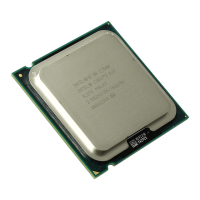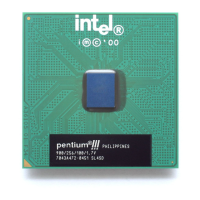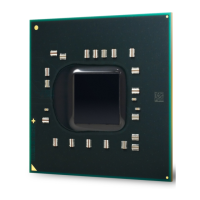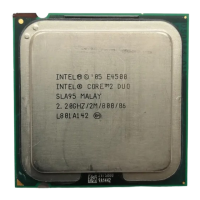Development Kit Features
2
nd
Generation Intel
®
Core™ Processor with Intel
®
6 Series Chipset Development Kit
March 2011 User Guide
Document Number: 325208-001 29
this interface is 2.7GT/s. The synchronization signals are directed from PCH to
processor.
3.1.7 Processor Thermals
The processor temperature is communicated to the Embedded Controller over the
PECI, a single wire interface..
Some important signals include:
• CATERR#: Indicates that the system has experienced a catastrophic error and
cannot continue to operate. It is indicated by red LED (CR1D1 on board).
• PROCHOT#: PROCHOT# will go active when the processor temperature
monitoring sensor detects that the processor has exceeded the thermal
specifications.
• THERMTRIP#: Assertion indicates that the processor junction temperature has
reached a level beyond which permanent silicon damage may occur.
3.1.8 Processor Active Cooling
The development board supports PWM-based fan speed control. Fan circuitry is
controlled by the signal CPU_PWM_FAN signal from the EC. On the board a 4-pin
header J3B1 is provided to support fan speed output measurement for the processor.
3.2 PCH Support
The development board supports the Intel 6 Series chipset, both MPI socketed and
soldered down on the board.
3.2.1 Introduction to the Intel
®
6 Series Chipset
The Intel 6 Series chipset is the next-generation platform controller hub (PCH). The
major differences between the Intel Q5 Series and the Intel 6 Series chipset PCH
include:
• DMI Gen 2 (5 GT/s)
• 8 PCIe 2.0 ports (5 GT/s)
• SATA/eSATA Ports - 6 ports (2 FIS-based switching) with up to 2 ports at 6 Gb/s
• 6 USB 2.0 ports (4 dedicated and 2 mux’ed with PCIe)
• Package Mobile FCBGA 989 balls, 25-x-25-x-0.6 mm FCBGA
• PCI interface is not supported
3.2.2 Key Power Management Signals
• RSMRST#: This signal from H8 initiates the Reset sequence in the Intel 6 Series
chipset.

